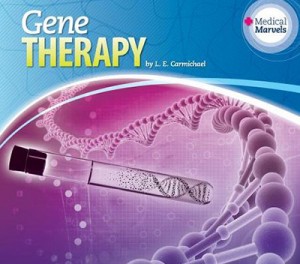 Muscular dystrophy, hemophilia, Leber congenital amaurosis (LCA), cancer… they all have one thing in common. They are genetic diseases, ultimately caused by missing or malfunctioning genes in the patient’s DNA. Until recently, we could treat the symptoms of many genetic diseases, but not the causes. There was no way to reach inside a person’s genes and repair the faulty code that started the whole problem.
Muscular dystrophy, hemophilia, Leber congenital amaurosis (LCA), cancer… they all have one thing in common. They are genetic diseases, ultimately caused by missing or malfunctioning genes in the patient’s DNA. Until recently, we could treat the symptoms of many genetic diseases, but not the causes. There was no way to reach inside a person’s genes and repair the faulty code that started the whole problem.
Research into gene therapy aims to change that.
What is gene therapy?
Genes are blueprints for proteins. A complete set of working proteins makes a working human. In contrast, missing or malfunctioning proteins sometimes lead to disease. Many genes and proteins have to be affected to lead to diseases like cancer. Other diseases, like LCA and Lesch-Nyhan syndrome, result from a single broken gene.
The logic behind gene therapy is very simple: if a missing or malfunctioning gene is causing disease, a working copy of the gene could cure the patient. There are two ways to provide a working copy:
- Fix the gene that’s already in the patient’s DNA. This is easiest when the malfunction is caused by what’s known as a “point mutation,” which is basically a typo in the genetic code. Not all such typos are dangerous, but the right typo in the wrong place can knock out the entire gene.
- Provide a new copy of the entire gene. This strategy applies for genes with larger insertions – extra code – or deletions – missing code.
Once a working gene is present in the patient’s cells, his or her body can make a functional protein… and in some cases, that may be enough to cure the disease.
That Does Sound Simple… So Why Is Gene Therapy So Hard?
Lots of reasons, but we’re going to focus on two:
- Cells have lifespans. Dying cells are replaced by new cells, which are created by cell division. During this process, the cell’s genome (all the DNA a person was born with) is copied so that each new daughter cell gets a complete set of instructions. There is no guarantee that a therapy gene that’s simply floating around in the cell will end up in both daughters – to ensure that the shiny new gene will always be passed on, making the cure permanent, that gene has to become part of the original genome. Which means that, either
- the patient’s original gene has to be edited in place, or
- the complete new gene has to embed itself into the patient’s existing DNA.
- According to one estimate, there are 37.2 TRILLION cells in the human body. Not every disease affects every cell in the body. For example, LCA is a form of blindness caused by a faulty gene in the cells of the retina. To cure LCA, only retina cells would need to be treated. Far fewer than the whole 37.2 trillion, but still enough that getting a working gene into EVERY retinal cell is still a huge challenge.
So How Do Scientists Solve These Problems?
Stay tuned! In Part 2, I will explain what CRISPR is and why scientists are so excited about it. In Part 3, we’ll tackle the “every cell” problem… and some awesome/scary breakthroughs that have recently hit the news.
In the meantime, you or your teenager might want to check out my YA science book, Gene Therapy. It’s a couple years old now, but is still a solid introduction to the history and science of this cutting edge medicine.